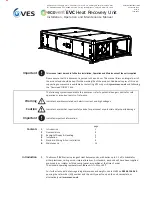
Installation Manual
When you return home contact your service
contractor to recharge the system with HTF.
After the system has been recharged, set the
controller to the “automatic” position. Reset
the time switch if necessary.
9) MAINTENANCE AND
TROUBLESHOOTING
The following procedures are intended to opti-
mize the performance of your SolaRay AC solar
water heating system and also to extend the life
of the primary components.
9.1 It is extremely important to monitor the
quality of the heat transfer fluid (HTF) on a
periodic basis. The chemical composition of
the HTF may change over time. A high quality
propylene glycol HTF capable of operating at
high temperatures should be used. The water
used to dilute the HTF is equally important,
water containing salts, acids, calcium or other
potential precipitates should not be used to
dilute the HTF initially or during subsequent
re-charges; de-ionized water is recommended.
The recommended propylene glycol HTF is
Dow Chemical “Dowfrost HD”. Technical and
engineering data for Dowfrost HD is available
at www.Dow.com.
A high quality HTF diluted with pure water and
properly maintained will prevent: appearance
of deposits on the piping; corrosion of compo-
nents; and loss of freeze protection. System pH
must be maintained between 8 and 10 to avoid
damage to the collector loop and absorber plate
piping Ask your installation contractor to estab-
lish a maintenance schedule to inspect, balance
or replace the glycol HTF as needed.
9.2 The second most important component in
your system, at least from a longevity stand-
point, is often ignored and never seen. We are
referring to the sacrificial “anode rod” installed
in your solar storage tank (COMPONENT #20,
FIGURES 15A; 15B; 16A; 16B; 17A; 17B ).
Typically constructed from magnesium, anode
rods are installed in “glass lined” water heaters
P.26
TANK SENSOR OPTIONS
fig. 18
JIFFY CLIP
Thermowell
















































